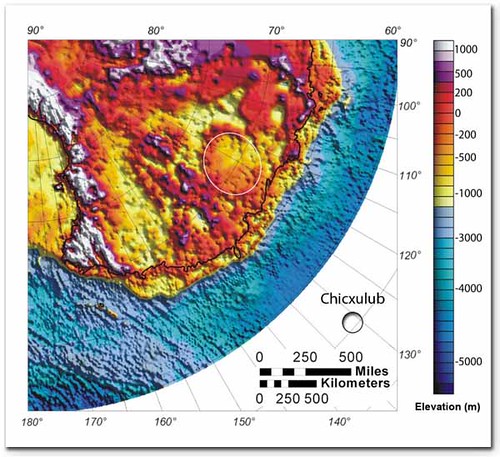Ancient mega-catastrophe paved way for the dinosaurs, spawned Australian
continent
COLUMBUS, Ohio -- Planetary scientists have found evidence of a meteor impact much larger and earlier than the one that killed the dinosaurs -- an impact that they believe caused the biggest mass extinction in Earth's history.
The 300-mile-wide crater lies hidden more than a mile beneath the East Antarctic Ice Sheet. And the gravity measurements that reveal its existence suggest that it could date back about 250 million years -- the time of the Permian-Triassic extinction, when almost all animal life on Earth died out.
Above, airborne radar image of land elevation in East Antarctica . Higher elevations appear red, purple, and white; the location of the Wilkes Land crater is circled (above center). Image courtesy of Ohio State University . An inset of the Chicxulub crater is included for comparison. Image courtesy of Ohio State University.
Its size and location -- in the Wilkes Land region of East Antarctica, south of Australia -- also suggest that it could have begun the breakup of the Gondwana supercontinent by creating the tectonic rift that pushed Australia northward.
Scientists believe that the Permian-Triassic extinction paved the way for the dinosaurs to rise to prominence. The Wilkes Land crater is more than twice the size of the Chicxulub crater in the Yucatan peninsula, which marks the impact that may have ultimately killed the dinosaurs 65 million years ago. The Chicxulub meteor is thought to have been 6 miles wide, while the Wilkes Land meteor could have been up to 30 miles wide -- four or five times wider.
"This Wilkes Land impact is much bigger than the impact that killed the dinosaurs, and probably would have caused catastrophic damage at the time," said Ralph von Frese, a professor of geological sciences at Ohio State University.
He and Laramie Potts, a postdoctoral researcher in geological sciences, led the team that discovered the crater. They collaborated with other Ohio State and NASA scientists, as well as international partners from Russia and Korea. They reported their preliminary results in a recent poster session at the American Geophysical Union Joint Assembly meeting in Baltimore.
The scientists used gravity fluctuations measured by NASA's GRACE satellites to peer beneath Antarctica's icy surface, and found a 200-mile-wide plug of mantle material -- a mass concentration, or "mascon" in geological parlance -- that had risen up into the Earth's crust.
Mascons are the planetary equivalent of a bump on the head. They form where large objects slam into a planet's surface. Upon impact, the denser mantle layer bounces up into the overlying crust, which holds it in place beneath the crater.
When the scientists overlaid their gravity image with airborne radar images of the ground beneath the ice, they found the mascon perfectly centered inside a circular ridge some 300 miles wide -- a crater easily large enough to hold the state of Ohio.
Taken alone, the ridge structure wouldn't prove anything. But to von Frese, the addition of the mascon means "impact." Years of studying similar impacts on the moon have honed his ability to find them.
"If I saw this same mascon signal on the moon, I'd expect to see a crater around it," he said. "And when we looked at the ice-probing airborne radar, there it was."
"There are at least 20 impact craters this size or larger on the moon, so it is not surprising to find one here," he continued. "The active geology of the Earth likely scrubbed its surface clean of many more."
There's definitely a story in there somewhere. But what is that story? Other than the obvious sentient trilobites, time travellers, space aliens and Cthulhu, I mean.
Now Playing: The Kinks Face to Face


No comments:
Post a Comment